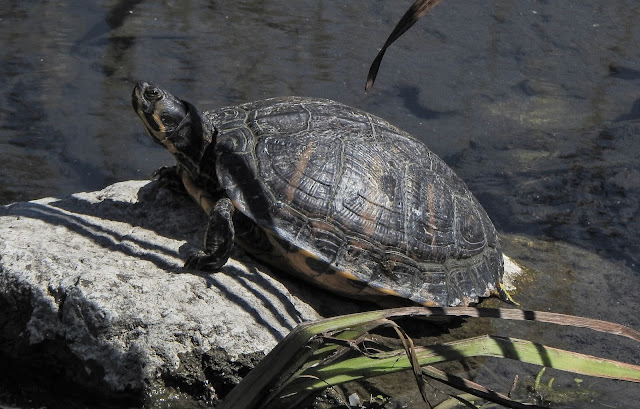The yellow-bellied slider (Trachemys scripta scripta) is a subspecies of the pond slider (Trachemys scripta), a semiaquatic turtle belonging to the family Emydidae. It is native to the southeastern United States, specifically from Florida to southeastern Virginia, and is the most common turtle species in its range. It is found in a wide variety of habitats, including slow-moving rivers, floodplain swamps, marshes, seasonal wetlands, and permanent ponds. Yellow-bellied sliders are popular as pets. They are a model organism for population studies due to their high population densities.
Adult male yellow-bellied sliders typically reach 5–9 inches (13–23 cm) in length; females range from 8–13 inches (20–33 cm). Melanistic males have been seen to grow larger than nonmelanistic males. The carapace (upper shell) is typically brown and black, often with yellow stripes. The skin is olive green with prominent patches of yellow down the neck and legs. As the name implies, the plastron (bottom shell) is mostly yellow with black spots along the edges. Adults tend to grow darker as they age. Yellow-bellied sliders are often confused with eastern river cooters, who also have yellow stripes on the neck and yellow undersides, but the latter lack the green spots characteristic of this species. The yellow belly often has an "s"-shaped yellow stripe on its face. They also have markings shaped like question marks on their bellies. Females of the species reach a larger body size than the males do in the same populations. There have also been studies that show females of this species have more symmetrical shells than males due to either more efficient growth or less hormonal stress.
Yellow-belly sliders range from southeastern Virginia, through the Carolinas, Georgia, northern Florida, and eastern Alabama. In European countries where pond sliders are established and invasive, that they can impose threats to native biodiversity through competitive advantage over native terrapins. They are often released into Europe from the pet trade, which makes them one of the top 100 invasive species outside of the United States.
Mating can occur in spring, summer, and autumn. They have polygynandrous mating behavior. Courtship consists of biting, foreclaw display, and chasing. Yellow-bellied sliders are capable of interbreeding with other T. scripta subspecies, such as red-eared sliders, which are commonly sold as pets. The release of non-native red-eared sliders into local environments caused the state of Florida to ban the sale of red-eared sliders in order to protect the native population of yellow-bellied sliders.
Mating takes place in the water. Suitable terrestrial area is required for egg-laying by nesting females, who will normally lay 6–10 eggs at a time, with larger females capable of bearing more. Studies have shown the turtles' suitable area criteria will not change even with significant anthropogenic change, meaning humans should be careful when modifying yellow-bellied slider habitats. The eggs incubate for 2–3 months and the hatchlings will usually stay with the nest through winter. Hatchlings are almost entirely carnivorous, feeding on insects, spiders, crustaceans, tadpoles, fish, and carrion. As they age, adults eat less and less meat, and up to 95% of their nutritional intake eventually comes from plants.


